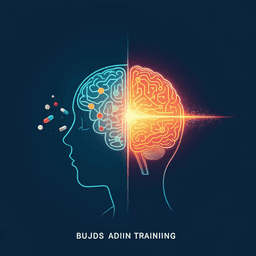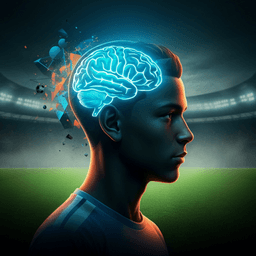
Psychology
Cognitive control training with domain-general response inhibition does not change children's brains or behavior
K. Ganesan, A. Thompson, et al.
An 8-week randomized trial in 235 children (6–13) found targeted response-inhibition training produced durable gains on closely related cognitive-control tests at 1-year but—surprisingly—no transfer to decision-making, academic performance, mental health, fluid reasoning, creativity, or brain structure/function. Bayesian analyses provide strong evidence of absent broader effects. Research conducted by Keertana Ganesan, Abigail Thompson, Claire R. Smid, Roser Cañigueral, Yongjing Li, Grace Revill, Vanessa Puetz, Boris C. Bernhardt, Nico U. F. Dosenbach, Rogier Kievit, and Nikolaus Steinbeis.
~3 min • Beginner • English
Introduction
The study investigates whether training a domain-general component of cognitive control—response inhibition—can produce improvements in children’s broader cognition and behavior. Cognitive control supports flexible, goal-directed behavior and is linked to social skills, academic performance, mental health, and long-term outcomes, developing through maturation of fronto-parietal and fronto-striatal circuitry. Prior interventions often report near transfer (task-specific gains) but inconsistent far transfer (generalization to distally related outcomes), with concerns about small effects, underpowered samples, and design limitations. This work examines, in a large randomized controlled trial, if an 8-week response inhibition training yields near transfer and far transfer across decision-making, academics, fluid reasoning, mental health, creativity, and brain measures; whether far transfer emerges over time; and whether near transfer mediates far transfer. It also tests whether cognitive control training buffers mental health against the stressor of COVID-19.
Literature Review
Previous cognitive training research, particularly working memory training, often shows improvements limited to trained or closely related tasks (near transfer) with weak or inconsistent evidence for far transfer to broader cognitive or real-world outcomes. Meta-analyses and reviews have questioned evidence quality, citing small samples, insufficiently variable training inputs, and limited outcome scopes. Recommendations include active control groups, clearly defined mechanisms, adaptive and diverse training, and comprehensive multi-domain assessments. Response inhibition has been proposed as a domain-general mechanism suitable for training due to its roles in stopping, selection, and monitoring. Hypotheses in the field suggest far transfer may depend on near transfer and may emerge only after time. Evidence also suggests cognitive control might buffer mental health during stress. This study addresses these gaps with a rigorous design, large sample, and extensive behavioral and neural measures over short-term and 1-year intervals.
Methodology
Design: Pre-registered randomized controlled trial with an active control. Participants: 235 typically developing children (ages 6.03–13.31; mean 8.97; ~52% female) recruited from 20 schools in Greater London (May 2019–May 2021). Random assignment to Experimental (response inhibition training) or Control (response speed training), matched by age, gender, school/class. Ethics: UCL ethics approval; parental consent and child assent.
Intervention: 8-week gamified, web-based Treasure Game (Gorilla platform), four recommended sessions/week (~15 min each; 1 at school, 3 at home). Both groups received identical narrative, stimuli, and intensity. Experimental group trained response inhibition via stop-signal task variations with adaptive staircase SSD (starting 200 ms, ±50 ms based on performance); stop trials 26–47% per session; SSD carried over across sessions for adaptiveness. Control group trained response speed, responding to all signals under adaptive time windows set by rolling performance (previous 10 trials + 2 SD).
Assessments: Three timepoints—pre (T0), post (T1), 1-year follow-up (T2). Due to COVID-19, some assessments conducted remotely; MRI collected only at T0 and T1. Outcome domains: cognitive control (nine tasks assessing inhibition/shifting/working memory including SSRT, flanker, Stroop, N-back 1/2-back, Corsi span, cognitive flexibility, AX-CPT), decision-making (Dictator Game, Ultimatum Game responder, intertemporal choice), academic performance (age-standardized English/Math scores), fluid reasoning (WASI-II Matrix Reasoning and Vocabulary), creativity (TTCT Figural Form A), mental health (SDQ parent-report internalizing/externalizing; CASI-4R subscales), apathy (AES-I).
MRI: Task fMRI during SSRT (EPI TR=1.25s, TE=35.2ms, 60 slices, 2 mm isotropic; two runs), cortical thickness (T1 MP-RAGE 1 mm isotropic; FreeSurfer), resting-state fMRI (5 min; ABCD-HCP pipeline; Gordon-333 parcels; mean within-network z for CON and FPN), DTI (100 directions, b=1000/2000; ExploreDTI; fronto-striatal (putamen) tracts, fractional anisotropy and mean diffusivity; track dissection reliability ICC>0.90).
Analysis: Mixed-effects models (lme4 in R) testing Session (pre vs post; and pre vs 1-year) × Group interactions, controlling for age and gender; Benjamini–Hochberg FDR correction; Bayesian factor (BF10) hypothesis testing to quantify evidence for null effects (model without interaction vs with interaction). Confirmatory factor analyses (lavaan) to derive cognitive control latent factors separately for error rates and reaction times and mental health latent factors; invariance constraints. Data imputation via MICE (predictive mean matching; multiple datasets), with FIML for latent factors. Power calculation targeted small interaction effect (f=0.1) with power 0.95 at Bonferroni-corrected alpha (0.0025) requiring n≥119; actual n=235. SES included in robustness analyses; retention 71.24% (T0→T1) and 99.40% (T1→T2).
Key Findings
Training indices: Motivation initially high (mean ~5.30/7) and decreased over weeks (F(6,308.75)=16.42, P<0.001) similarly across groups (t(395.13)=-0.50, P=0.61; BF10=0.23). Number of sessions similar (Exp 16.60±8.35; Ctrl 16.99±8.55; t(205.33)=0.33, P>0.740; BF10=0.16). Both groups improved on trained functions over weeks (Exp SSRT slope F(1,2292.60)=121.30, P<0.001, η²=0.05; Ctrl Go RT slope F(1,3197.5)=185.57, P<0.001, η²=0.05).
Short-term near transfer: Significant Session×Group interaction for probability of successful stopping (SSRT) (F(1,221.00)=27.31, PFDR<0.001, η²=0.11). Exp increased (t(215)=-5.96, P<0.001); Ctrl no change (t(218)=1.43, P=0.92). Go RT interaction significant (F(1,227.28)=31.75, PFDR<0.001, η²=0.12): Exp increased (t(228)=-5.02, P<0.001), Ctrl decreased (t(228)=2.94, P=0.021).
Short-term far transfer—behavioral: Cognitive control error-rate inhibition/shifting factor interaction significant (F(1,215.68)=10.678, PFDR=0.006, η²=0.05) but follow-ups showed no significant pre–post change in either group; memory error factor no interaction (F(1,212.72)=0.090, P=0.764; BF10=0.188); reaction-time factor interaction (F(1,213.71)=18.60, PFDR<0.001, η²=0.08) with Exp general slowing and Ctrl speeding. Decision-making: no interactions for DG offers (F(1,199.18)=0.144, P=0.705; BF10=0.201), UG acceptance (F(1,196.49)=2.36, P=0.126; BF10=0.176), intertemporal delayed choices (F(1,203.60)=1.01, P=0.317; BF10=0.150). Academics: no interaction (F(1,217.35)=0.266, P=0.606; BF10=0.159). Fluid reasoning (WASI): no interaction (F(1,211.92)=0.351, P=0.554; BF10=0.169). Mental health: internalizing no interaction (F(1,125.47)=4.10, P=0.159; BF10=0.194); externalizing no interaction (F(1,123.94)=0.972, P=0.326; BF10=0.228). Creativity (TTCT): no interaction (F(1,209.32)=3.373, P=0.068; BF10=0.448).
Short-term far transfer—neural: Whole-brain task fMRI: no Session×Group interactions after correction. rIFG ROI activation: Group main effect (F(1,271)=11.43, P<0.001, η²=0.04; higher overall activation in Control) but no interaction (F(1,271)=3.87, P=0.050; BF10=1.105). Cortical thickness (whole brain and rIFG ROI): no interactions (rIFG F(1,139.85)=0.016, P=0.901; BF10=0.200). Resting-state connectivity: CON (F(1,141.34)=0.053, P=0.819; BF10=0.180), FPN (F(1,143.14)=0.162, P=0.688; BF10=0.187) no interactions. DTI right fronto-striatal putamen tracts: FA (F(1,141.63)=0.134, P=0.715; BF10=0.188), MD (F(1,144.24)=0.019, P=0.891; BF10=0.211) no interactions.
Long-term near transfer (1-year): SSRT probability of successful stopping interaction (F(1,227.16)=8.68, PFDR=0.018, η²=0.04); Exp remained increased (t(217)=-4.38, P=0.001); Ctrl no change (t(218)=-0.202, P=1.000). Go RT interaction (F(1,235.94)=13.32, PFDR<0.003, η²=0.05); Exp remained elevated (t(231)=-6.992, P<0.001); Ctrl no change (t(230)=-1.844, P=0.399).
Long-term far transfer (subset due to COVID restrictions): No Session×Group interactions for Corsi memory span (F(1,228.05)=0.147, P=0.702; BF10=0.152), AX-CPT proactive control (PBI) (F(1,445)=0.340, P=0.560; BF10=0.165), cognitive flexibility (F(1,227.71)=1.78, P=0.183; BF10=0.294), DG offers (F(1,204.53)=2.74, P=0.099; BF10=0.450), UG acceptance (F(1,198.66)=0.385, P=0.536; BF10=0.174), intertemporal delayed choices (F(1,202.89)=0.116, P=0.733; BF10=0.166), internalizing (F(1,154.70)=2.23, P=0.138; BF10=0.207), externalizing (F(1,147.47)=0.573, P=0.450; BF10=0.162).
Mediation: Near transfer (successful stopping) did not predict changes in any far transfer measure.
COVID-19 buffering: Apathy increased after lockdown (F(1,178.29)=29.82, P<0.001) with no buffering by training (F(1,178.78)=0.014, P=0.905; BF10=0.188). SDQ total (strengths & difficulties) showed no buffering effect (F(1,154.32)=3.05, P=0.083; BF10=0.141).
Robustness: Controlling for SES did not alter outcomes. Bayesian analyses provided substantial evidence for absent training effects across far transfer behavioral and neural domains.
Discussion
The intervention effectively improved the targeted processes: response inhibition training increased stopping success and induced proactive slowing, while response speed training improved speed. These near transfer effects persisted for at least one year, indicating durable task-specific gains. However, the training did not generalize to broader cognitive control performance (beyond general slowing), decision-making, academic achievement, fluid reasoning, creativity, or mental health. Nor were there detectable neural changes in task-related activation, cortical thickness, resting-state network connectivity, or white matter microstructure. Findings counter two prevalent claims: that far transfer depends on near transfer and that far transfer emerges only after time. Additionally, response inhibition training did not buffer mental health during the COVID-19 stressor. The results suggest that capacity-oriented training of cognitive control, at least via response inhibition, does not translate into meaningful changes in children’s brains or everyday behavior. This supports frameworks emphasizing motivation and value-based allocation of control over resource-augmentation accounts.
Conclusion
In a large, pre-registered RCT with an active control and comprehensive measurement, response inhibition training produced durable near transfer but no far transfer to cognitive, behavioral, academic, or neural outcomes, and no delayed emergence of far transfer. The work cautions against investing in capacity-focused cognitive control trainings to achieve broad developmental benefits. Future research should explore interventions targeting motivational and effort valuation mechanisms that may better foster generalizable improvements in cognitive control and related outcomes, and assess efficacy in diverse populations and contexts.
Limitations
- Training dose/implementation may still have been insufficient despite 8 weeks.
- Sample skewed toward higher socioeconomic status; generalizability to lower SES or clinical populations is uncertain.
- COVID-19 disruptions led to remote testing for some participants and no MRI at 1-year follow-up.
- Retention from pre- to post-test was ~71%, potentially affecting power for some outcomes at T1.
- The active control targeted response speed; different control designs might yield different comparative dynamics.
Related Publications
Explore these studies to deepen your understanding of the subject.







